
The following will be of interest for its value as to how the city fathers met the conditions of the day when manpower and money were at a premium towards "getting the job done." The complete wordage of the Ordinances has been deleted and only a synopsis is offered, taken from the By-Laws and Ordinances of the Village of Wymore, Nebraska 1883.
Ordinance I-Providing rules, by-laws, order of business for the governing board of Trustees of the Village of Wymore.
Ordinance II-An ordinance to license and regulate the sale of malt, spirituous and vinous liquors in the Village of Wymore.
Ordinance III-Licenses of certain vocations, traveling Dentists and traveling Doctors shall be deemed peddlers and requested to procure license to practice their profession. This ordinance also covered all itinerant salesmen, shows, circuses, medicine shows, auctioneers, etc.
Ordinance IV-Provided for the planting of shade trees by the owners of property. Section three of this ordinance specifies that each owner is also to provide a substantial hitching post and maintain some. Section five specifies that any person guilty of hitching or fastening horse, mule or ox or other animals or teams to any shade trees shall be fined $10.00 and costs.
Ordinance V-An ordinance providing for two days labor upon the streets of the Village of Wymore. Section One provides that all able-bodied males between the ages of 21-50, shall between the first day of April and the first day of November in each year, either by themselves or satisfactory substitute, perform two (2) days labor upon the streets, alleys, or highways within the corporate limits of said Village.
Ordinance VI-Providing for the manner of building sidewalks, levying and collecting assessments for the payment thereof. Section Two provides that sidewalks other than in the business district shall not be less than four feet in width and shall be laid on stringers not less than two by four inches in size. The cross boards shall not be less than one inch in thickness and to be securely nailed to said stringers.
Ordinance VII-An ordinance establishing grade on certain streets in the Village of Wymore .
Ordinance VIII-An ordinance defining misdemeanors and fixing punishment. Section 14 states whoever shall immoderately ride any horse or mule along any street or any other public place, or shall immoderately drive any horse, mule or team attached to any vehicle or deliberately or wrongfully run upon or come in collision with any person, animal or thing lawfully being in the street or public place, shall be deemed a misdemeanor.
Ordinance IX-An ordinance defining nuisances and fixing the punishment and abatement thereof. Section I. Any one causing or suffering any offal, filth or noxious substance to collect in the Village to the prejudice of others, will be considered a nuisance. | 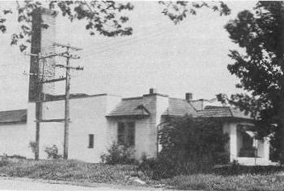
The City Water & Light office which also houses the City Council meeting room, Police Headquarters and store room for supplies for the light and water systems as well as housing for city owned trucks. The old smoke stack dates back to the steam generating plant many years ago.
Ordinance X-An ordinance to guard against fire and prohibit the use of stove-pipes in certain cases, and creating the office of fire warden and defining his duties.
Ordinance XI-An ordinance relating to offenses by obstructing or throwing trash in the streets of the Village of Wymore, Nebraska. Section I. provides that no person should throw or place anything that would make a litter or frighten a horse .
Ordinance XII-An ordinance providing for and levying taxes in and for the Village of Wymore, Gage County, Nebraska, for the fiscal year commencing on the first Tuesday in May, 1883 A. D. and ending on the day preceding the first Tuesday in May, 1884 A. D.
Ordinance XIII-An ordinance to license and tax dogs and prohibit their running at large in certain cases and providing for the enforcement and collection of such tax.
That completed the text of the ordinances and it was attested to the fact that it was advertised in the WYMORE EAGLE, by its publisher Chas. T. Taylor, and was forwarded to the county seat in Beatrice for recording as well as one copy to the State. From the revised ordinances of 1909 we find in its opening statement, "The City of Wymore, Nebraska, was organized as a City of the Second Class in April, 1884," which leaves us with the idea of course, that Wymore graduated from Village to City, in the span of her first two years . . . The one big difference between the status of Village and City in this particular case was that as the original Village it was under a Village Board form of government, with a chairman and several board members and a clerk. The chairman of the board acted in the same capacity as a Mayor. The Mayor plan was adopted under the City form of government instituted in 1884.
The first chairman of the Village Board was a Mr. E. Hitchings, with Mr. A. D. McCandless village clerk. The first elected Mayor was Daniel McGuire, 1884-85. Since that time until the present time we have had no less than 72 while at the present time Mr. R. S. Jones is serving his term as Mayor. The changes instituted within the contents of the original bill of |
| 9 |
|
ordinances from 1883 offered quite a contrast to those of 1909. There were changes in the provisions for sidewalks for a change over from the board-walks to those of concrete. There were clarifications instituted in the manner of handling of livestock through the City on City streets. Livestock was to be led by halter or rope and not driven. There was the introduction of of city water and light system, and curb lines were established. We note that vagrancy was defined and particular attention given "free riding knights of the rood" and gypsies.
There was on addition of twenty ordinances over the original thirteen and not all of the original ordinances have become obsolete for some are still a necessary part of our present City Government after seventy-five years of protection for Wymore's citizenry, whereas many of the original ordinances had their humorous twist as applied to the changes of the times and conditions. Also in the light of the automobiles, jet planes and diesel engines, none of the ordinances went without their moral tenur for an over all application towards good of the community.
Our present system of City Government is the same as that introduced in 1884, We have a Mayor already mentioned as R. S. Jones, a City Council comprised of Roy Eklund and Ivan Kohlmeyer representing the Second Ward and W. J. Wilson and Warren Snook of the First Ward. Our present ordinances number 172, which all goes to make Wymore a good place to live...
The following served as Mayor of the City of Wymore from 1884 to 1956:
1884-1885 Daniel McGuire
1885-1886 Reginald W. Laflin
1886-1887 Reginald W. Laflin
1887-1888 Horace A. Greenwood
1888-1889 Julius Neumann
1889-1890 Patrick M. Hobb
1890-1891 Daniel K. Taylor
1891-1892 Elisha P. Reynolds, Jr.
1892-1893 Elisha P. Reynolds, Jr.
1893-1894 Gus Graff
1894-1895 Gus Graff
1895-1896 Dr. P. M. Hobbs
1896-1897 Dr. C. C. Gafford
1897-1898 Julius Neumann
1898-1899 Julius Neumann
1899-1900 J. R. Dodds
1900-1901 J. A. Reuling |
1901-1902 J. R. Dodds
1902-1903 J. R. Dodds
1903-1904 Gus Graff
1904-1905 Herbert J. Wetmore
1905-1906 L. H. Archard
1906-1907 L. H. Archard
1907-1908 Dr. Henry G. Given
1908-1909 Dr. S. E. Yoder
1909-1910 M. L. Rawlings
1910-1911 M. L. Rawlings
1911-1912 E. E. Mauck
1912-1913 J. A. Reuling
1913-1914 J. A. Reuling
1914-1915 I. T. Cutshall
1915-1916 Adam McMullen
1916-1917 M. L. Rawlings
1917-1918 John Endelman
1918-1919 George Currie
1919-1920 C. H. Hanson
1920-1921 C. H. Hanson
|
|
1921-1922 B. O. Youll
1922-1923 B. O. Youll
1923-1924 B. O. Youll
1924-1925 B. O. Youll
1925-1926 B. O. Youll
1926-1927 Benjamin E. Norris
1927-1928 Benjamin E. Norris
1928-1929 D. W. Heusman
1929-1930 D. W. Heusman
1930-1931 D. W. Heusman
1931-1932 D. W. Heusman
1932-1933 L. W. Reese
1933-1934 L. W. Reese
1934-1935 L. W. Reese
1935-1936 L. W. Reese
1936-1937 C. W. Tumblin, Sr.
1937-1938 C. W. Tumblin, Sr.
1938-1939 C. W. Tumblin, Sr.
1939-1940 C. W. Tumblin, Sr.
| 1940-1941 C. W. Tumblin, Sr.
1941-1942 C. W. Tumblin, Sr.
1942-1943 W. E. Wright
1943-1944 W. E. Wright
1944-1945 L. R. Heusman
1945-1946 L. R. Heusman
1946-1947 K. O. Parrish
1947-1948 K. O. Parish
1948-1949 L. R. Heusman
1949-1950 L. R. Heusman
1950-1951 L. R. Heusman
and Carl Parks, acting
1951-1952 Carl Parks
1952-1953 A. F. Scheideler
1953-1954 A. F. Scheideler and R. S. Jones, acting
1954-1955 R. S. Jones
1955-1956 R. S. Jones
|
The following served as Chief of Police for the City of Wymore from 1884 thru 1956.
1884-1885 W. H. Carmichael
1885-1886 William Hackler
1886-1887 William Hackler
1887-1888 William Hackler
1888-1889 F. W. Acton
1889-1890 F. W. Acton
1890-1891 F. W. Acton
1891-1892 F. W. Acton
1892-1893 F. W. Acton
1893-1894 F. W. Acton
1894-1895 F. W. Acton
1895-1896 F. W. Acton
1896-1897 G. F. Hewins
1897-1898 F. W. Acton
1898-1899 F. W. Acton
1899-1900 F. W. Acton
1900-1901 F. W. Acton
1901-1902 F. W. Acton
1902-1903 F. W. Acton
1903-1904 F. W. Acton
1904-1905 F. W. Acton
1905-1906 F. W. Acton
1906-1907 Charles A. Allen
1907-1908 P. T. Burk and George Noll
1908-1909 J. B. Schlanger and Dennis Hatch
1909-1910 Dennis Hatch and Barney Schlengen
1910-1911 Barney Schlengen
1911-1912 W. W. Chinnock
1912-1913 W. W. Chinnock
1913-1914 W. W. Chinnock
1914-1915 C. W. Lytle
1915-1 916 C. W. Lytle and W. W. Chinnock
| 1916-1917 James O'Neal
1917-1918 Arthur Gillispie, M. M. Fields and C. W. Lytle
1918-1919 C. W. Lytle
1919-1920 C. W. Lytle
1920-1921 C. W. Lytle
1921-1922 C. W. Lytle
1922-1923 C. W. Lytle
1923-1924 C. W. Lytle
1924-1925 C. W. Lytle
1925-1926 C. W. Lytle
1926-1927 C. W. Lytle
1927-1928 C. W. Lytle
1928-1929 C. W. Lytle
1929-1930 W. M. Chambers
1930-1931 W. M. Chambers
1931-1932 W. M. Chambers
1932-1933 C. W. Lytle
1933-1934 C. W. Lytle
1934-1935 C. W. Lytle
1935-1936 C. W. Lytle
1936-1937 William Kelley
1937-1938 William Kelley
1938-1939 Harry Herman
1939-1940 Harry Herman
1940-1941 Harry Herman
1941-1942 H. R. Booe
1942-1943 H. R. Booe
1943-1944 H. R. Booe
1944-1945 William Kelley
1945-1946 William Kelley
1946-1947 Charles Canfield
1947-1948 Charles Canfield
1948-1956 H. R. Booe still serving
|
|
 |
| 10 |
|

Every city must have a cultural and intellectual background. This cannot be gained as efficiently nor so effectively as through the medium of books. Books give a depth and dimension to intellectual stability that is only short of actual participation. Books lead us to the great arts, philosophy, sciences and religion. We of Wymore have been very fortunate that over the years we have had available the finest of libraries. It has afforded to us the best in good reading material.
A brief history of our library.
Taken from the Weekly Wymorean of Dec. 15, 1900: "The Library has completed the first year of its history. The report shows an attendance of 10,296 visitors. Number of books in library, 478 bound, 36 unbound, 8 periodicals are being received regularly. Number of loans made 1282. Amount collected during the year was $595.75, all of which was expended for expenses, etc. The librarian's salary was $180.00. Laurie M. L. Vance is the librarian."
Miss Pauline Ragan, our present. librarian, has gleaned the following information from old records of the library board found on file, as reported in the Arbor State of Nov., 1955. "The first library in Wymore was located in the Greenwood building, part of where the dance hall is now, over the bank, and Mrs. L. L. Vance was librarian. That was back in the early 1900's. Sometime later it was moved over Pennington store, now occupied by Don's Radio and TV Service.
"Records of the first minutes at meetings of the library board were dated January, 1917, at which time there were nine members on the board. No reference was made as to having a librarian.
"In January, 1917, a letter was written to the Carnegie Corporation concerning the building of a library. In April, 1917, plans for the new building were discussed and A. W. Grant of Beatrice was accepted as architect to draw the plans.
"In May, 1917, Mr. Grant's plans were accepted by the board and referred to the Carnegie Corporation for approval. No reference was made as to how much support the city was given by the Carnegie Corporation. | 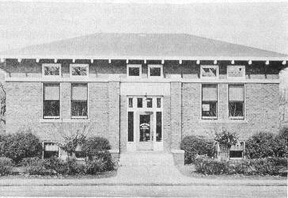
"At first it was agreed that the library was to be built in the Burlington park or Rawlings Park until Mr. Whitson offered to donate the present site which was accepted by the board. Work was started on the building in Nov. 1917 and the new library was opened on May 15, 1919. Miss Lulu Williams was elected librarian. Library hours were to be 2:30 to 5:30 in the afternoon and 7:00 to 9:00 in the evenings. Fines were 2c per day and magazines had to be more than two months old to be checked out.
"Today, the library has 10,103 volumes, 271 being added last year alone. There are 1073 registered borrowers, with 123 being non-residents of the city. Last year 14,202 books were borrowed, 6,078 being adult books and 8,124 being children's books. Fines collected during the year amounted to $128.15.
"In addition to her other work, Miss Pauline Ragan is often called upon to do reference work, checking to see where her patrons can find certain information. Last year she answered 591 questions, some of which required considerable time.
"Miss Ragan began her work at the library under Miss Gladys Pirie who served as librarian from November, 1920 until she resigned in May, 1952.
"Besides the 10,000 books in the library, Miss Ragan often orders books from the Inter-Library Loan at the Nebraska Public Library Commission in the State House at Lincoln. Last year she secured 43 books in this manner." |
 |
| 11 |
|

|
The Wymore-Blue Springs Street Railway was incorporated Nov. 4, 1884 by Elisha P. Reynolds, Sr., of Rock Island, Ill., V. J. Smith of Lincoln, Nebr., John H. Reynolds, Ben Reynolds, Elisha P. Reynolds, Jr., Samuel Wymore and Patrick A. Monagon, all of Wymore, Nebraska with a capital stock of $10,000 which was increased to $50,000 Nov. 3, 1885. It started operation Dec. 1, 1885 with E. P. Reynolds, president; J. H. Reynolds, vice president and Ben Reynolds as general manager.
The track ran from 6th Ave. and D street one block west to 7th and D, thence north to 7th and F (Neumann's Store), thence west to 10th and F (Methodist Church), thence north to 10th and K, thence east to 9th and K, thence north to 9th and M, thence east to 5th and M, where 5th Ave. and the railroad intersect. The track crossed the railroad on a bridge (north of the mill), thence north to the street car barn then over Bills Creek and north to the Blue Springs Bank, thence east on Blue Springs main street to the Blue River bridge.
The car left Wymore at 6:40 a.m. and approximately every hour until 8:30 p.m., and left Blue Springs at 7 :20 and approximately every hour thereafter to 9:10.
During the County Fair which was held in Wymore for several years, more cars were added and they only ran to the summit which was the street car barn, as the entrance to the fairgrounds which is now Arbor State Park, was on 7th Ave., west of the caretakers residence now.
The route followed the best residential district in Wymore at that time and the railroad officials and the Reynolds residence were on the route. The cars met the passenger trains on the U. P. at Blue Springs and the Burlington trains at Wymore and carried a good many passengers at train time as well as the mail. The street car company attempted to build the track across the river bridge at Blue Springs to the U. P. depot but were prevented from doing so by injunction.
The following account of some of the trials and tribulations of the operator of a horse drawn street car were recently related by a Wymore man. Perhaps the reason he remembered them so well was that he | 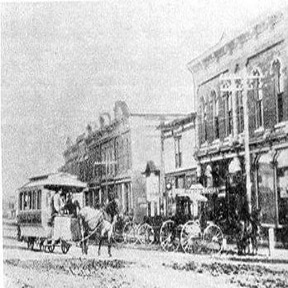
The old horse drawn street car starts around the present bank corner at Blue Springs on its way back to Wymore. This picture, the only one found, was furnished through the courtesy of the Rice Sisters in Blue Springs.
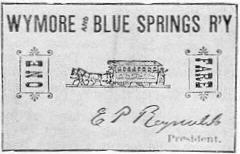
One ticket for the ride on the street car remains in existence. This is a copy of the one owned by Frank Fulton of Wymore.
had a part in the experiences related.
There was an ordinance passed by the Wymore council to prevent boys from hooking a ride on the cars but this was not popular with the boys so they just ignored it and kept the police and drivers busy |

|
| 12 |
|
keeping them off of the cars between the Methodist Church and Newton's corner which was 10th and K. But the boys were more or less justified for the reason that on a cold day the driver would pick up 2 boys and have them jump off and gather up sticks and cobs or anything along the street that would burn and after they had a good fire going in the stove, he would put them off over by the bridge or even in Blue Springs and they could walk back.
In order to keep the scales of justice balanced the boys had rollers and bars in a barn near the Episcopal Church and there was an old hitching post made of stone about one foot square and 4 feet long in front of the C. W. Robertson home and while the car was north the boys would roll this stone on the track and when the car came back the driver could not handle it and when he went to town to get help the boys would pull the pin on the single tree and put the horse on the north end and take a ride back north and let the driver do some walking.
There was a boy who was adept at driving the horse with a barrel stave and after dark a little boy would get on the back of the car and the driver would start through the car to chase him off and two big boys would get on one at each end of the car | and get a hold of the doors and hold the driver inside the car. Then the boy with the barrel stave would get on in front and hit the horse with the barrel stave. Everytime he would hit on a gallop and the car would go around Newton's corner on two wheels. Yet once in a while the driver would get the best of the argument.
Two little boys once put a railroad torpedo on the track in front of the Tony Hirman's place and hid behind the house. Two other boys, not knowing the torpedo was on the track, were sitting on the curb waiting to hook a ride. When the car was right in front of them the torpedo went off and blew the car off of the track. The two boys sitting on the curb, deeming discretion the better part of valor, took to their heels but when they both attempted to go through the fence between Neumann's and Hirmons where the pump was, at one and the same time, neither one go through and the driver really gave them a threshing with the whip.
The street car barn burned down and the Railway was abandoned in 1896 and was assigned to E. P. Reynolds for $64.70 after which the tracks were taken up and sold as junk. |
|

|
As we have pointed out, the beginning of the growth of Wymore following the advent of the establishment of the Burlington railroad here, a great deal of credit for that growth is due to the confidence and the foresight of the early pioneer merchants and professional people who came here to establish business, "hang out their shingles" and make their homes. There was no shadow of defeatism or pessimism as they rolled up their sleeves and went to work against odds that would litterly "floor" the present day merchantman, what with lack of high speed transportation, inadequate or no roads, hard to obtain merchandise, etc.
There has to be, by necessity, those who provide the wherewith to build homes, stock and provide larders, care for the sick, which all goes to make a well knit society. We don't have, of course, the motives that prompted each individual to uproot his social
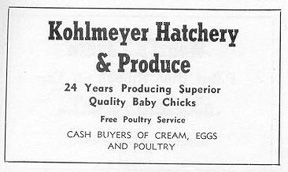
| existence, whatever they might have been, and transplant themselves into this realm of virgin territory, but granted for the most part that it was prompted by financial gain, they gave in return a substance to the community that could not be measured by monetary value alone.
"The Gage County Democrat" a Beatrice paper of those times printed under June 24, 1881 the following summary: "Although Wymore has been platted but sixty days, hundreds of lots have been sold, and residences and business houses going up on every hand and are being occupied as fast as enclosed. In the business part of the town we found the store of J. S. Johnson where a full line of merchandise is kept (Mr. Johnson was originally from Blue Springs) The Reynolds House by Z. C. Rockwell is a frame building 40x50 feet, when completed will be one of the finest hotel buildings in the county, the upper story will contain 22 rooms. The Grand Central, by David Greenstreet is a first class stopping place, the house as now completed in an "L" 18x30, the main part of the building not being enclosed. The front or main part of the building is 30x50. The house is filled to capacity. Another hotel by D. F. Miles, 22x 54 feet is two stories high. All hotels are full. There are now two lumber yards and two more are coming in as soon as they can get stock. G. W. Rummell is putting up a hardware store 40 x 40 by 20 feet high, will open within 60 days. Mr. Casey has just completed a 20 x 30 room to be occupied by a merchant tailor. E. C. Perey will open a stock of groceries and hardware in a room 20 x 40 finished by Mr. Leach. Mr. Meyer is putting the finishing touches on |
| 13 |
|
his 20 x 30 store and has a general stock at merchandise ready to move. Chas. Wachtel has his 20 x 30 room finished and ready for the stock of furniture that he will put in within the next few days.
"A. J. McLahn has put up a two story building, 20 x 30, and is fitting it for a restuarant. Mr. Sullivan, the popular barber has a neat shop 16 x 30, two stories. Mr. Johnson has just finished a room 14 x 20, two stories high. Mr. Leach has just put up a room 20 x 30 that will be occupied as a barber shop. John Vesley has groceries, his room is 12 x 38. John Wazel has his 20 x 35 room completed and will put in a temperance billiard hall. John Pisar has a building 20 x 21 raised, when completed Mr. Harris of Crete will put in a general stock. Mr. Sitz is building a room for a drug store, 24 x 32.
Dr. J. E. Kihler has put up a nice building 20 x 30 for an office and will look after the health of the Wymore folks. F. M. Taylor will put up a stone building 22 x 48, two stories high to be used as a restuarant. Mr. Ake has purchased a residence lot and also made application to the Railroad Company for grounds on which to build coal sheds and will handle that commodity. Crane Bros. from Kansas have purchased a site for an elevator and stock yards, also a building lot, and will handle grain and stock. Wiggens & Son are going to build an elevator and the Filley and Day stock yards.
"Besides these the B. & M. Co. have their yards staked out and will have them ready for use in a short time. In the matter of building material, some of the finest quarries in the county lay just across the creek and within a half mile of Wymore. Brick making is carried on by Wakefield and Crane who have had extensive experience in this line of business. The Gentlemen inform us that the clay is the best they have worked anywhere in the west. They have a kiln nearly ready to fire.
"As a means of affording easy access to Wymore, the B. and M. Railroad Co. propose to plank their bridge over the Blue, east of the town and make a wagon road free for all, thereby placing Wymore at the very edge of the beautiful lands now held in reserve by the Otoes." (We offer a footnote, that the Otoe reservation referred to here went on sale May 31st, 1883. It embodied thousands of acres of rich form land and was offered for auction in 160 acre | parcels to individual buyers, thus enriching Wymore’s position as a trading terminus for the many families who settled there.)
It would be a difficult task to tabulate and to give a complete synopsis of all the merchants that have set up business here and moved on, however it is only fair to note at random and at various times the different merchants and professional men who served the needs of the community.
We would like to take at random a few of the names appearing in the 1911 "Special Illustrated Edition of the Weekly Arbor State"--names that some will vividly recall from out of the past and some will be recognized by the youngsters in our midst at the present time: E. N. Kauffman, attorney at law practiced in Wymore from his arrival in 1884; Adam McMullan, attorney and graduate of Wymore Schools (later to become governor of the State of Nebraska); F. E. Crawford, attorney, graduated from Wymore High School in 1898, graduated from the University of Nebraska 1903; Judge A. D. McCandless, attorney and can truly be remembered as the father of Wymore's parks; L. V. Douglas, Dentist; Dr. L. R. Fritz, Dentist; Dr. F. W. Winter, M. D., one of the oldest physicians by point of residence since 1882. Dr. Clara Henke, osteopath; Dr. Frances Elias, M. D., who started his practice in Wymore in April, 1911, graduated from the University Kansas; Dr. C. H. Willis, M. D., examining surgeon for the Wymore Division of the Burlington R. R.; E. W. Severance, runs local Auto Livery business, has "commodious garage and repair department"; C. W. Robertson, dry goods, shoes and groceries, in Wymore since 1883; Scheidler Bros., A. F. and H. F., wholesale and retail cigars of all kinds and pool parlor.
J. S. Jones, Cashier First National Bank; M. J. Moran, partner with Mr. G. T. Stephensen in the Real Estate Business; A. J. Bruce, manager of Searle and Chopin Lumber Co.; Joseph Martz, photographer; P. F. Ahlquist, manager of telephone office; Kelly Bros. Implement Co., W. J. and L. F., F. F. Fulton Monument dealer since 1904 (still active in the same business); Julius Neumann, president and manager of the Julius Neumann Company, came to Wymore in 1882, is also vice president of the Farmers and Merchants Bank. |
 |
| 14 |
|

